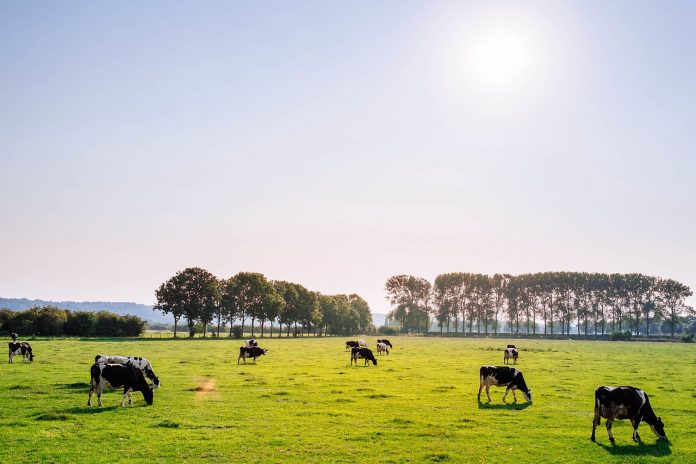As we wrap up 2022 and kickoff 2023, it has me thinking of what has been accomplished and what goals lie ahead. It’s a new year and a great time to think forward into what we might expect in the new year. Here are three things I am watching for in pastures and hayfields in 2023:
Asian Longhorned Tick
The Asian Longhorned Tick (ALHT) has been making slow but steady progress across pastures and fields from the eastern Mid-Atlantic through the Appalachian regions and into Ohio. It has the potential to become a productivity-limiting factor in many operations if left ignored. The time to plan for it in your fields is now.
It could present a few management conundrums in your pasture. If you have sheep, goats, cattle, chickens, dogs, cats and if deer and raccoons roam about your property, this is a tick that you should be watchful for and take proactive measures to protect you and your livestock.
A heavy infestation of ALHT will likely decrease productivity. We have already seen cases in Ohio that resulted in animal fatalities because the population quickly overwhelmed the host animals. The threat to livestock is disease or exsanguination. Theileria is a disease that is transmitted to livestock which we will need to be alert to. If conditions are right these rapid infestations can occur in a matter of days, so a high level of attentiveness is warranted.
Best management practices for our region and production systems are still being worked out and these are discussions I expect to hear more about and share in my own work in the coming year. Be proactive to maintain a relationship with a veterinarian so if medications and treatments become necessary you have access to those options on short notice.
ALHT thrive in tall pasture grass. Keeping grass short helps reduce spread so keeping fields mowed will be part of a recommendation. This may go against your preferred grass management for the biomass you need for feed. ALHT management will rely on an Integrated Pest Management System that will require attentiveness in order to prevent infestations. The good news is we can look to other parts of the world that have coexisted with ALHT as we work out how to manage for it on our farms.
Invasive shrub control
We constantly manage to keep certain plants out of our pastures and old problems persist. Autumn olive and multiflora rose are excellent colonizers in our region and compete for available grazing area. I am involved with a small group of colleagues that is evaluating current practices for managing these invasive shrubs. Over the years there have been several recommendations for management. We seek to follow those and try out a few new formulations, price points and think about what might already be on the shelf to use as we try to keep these plants at bay.
In some places, it is a constant battle to work against these plants in our fields. Our group has access to some very severe infestations in southeast Ohio. We have already applied with backpack sprayers and ATV mounted sprayers in a replicated trial, and we will be watching closely to see what happens in 2023. On my own property I treated a multiflora rose in a fenceline and I am curious to see what returns (hopefully none) in 2023.
Drone use on the farm
This fall I attended a program and was confidently told, “2022 will go down in history as the year drones started being used in agriculture.” It has certainly been a conversation, perhaps for the past decade and longer, but it seems awareness of drone applications in 2022 was very high and many demonstrations and uses caught attention. It helps that drone videos make good social media fodder.
Many years of theoretical concepts and designs took flight in real uses to accomplish profitable on-farm tasks. Just by writing this I am contributing to the proliferation of articles and media about agricultural drone use. Beyond the utility of a camera, we have seen drones used for herbicide spraying and seeding cover crops, just to name two. I’m sure there are other examples, but these gained a lot of interest through summer and fall and are what I heard most about.
Money and resources are getting channeled into this space to discover what can be done on the farm with a drone in the race to determine profitability and time-saving benefits. I expect to continue to see individuals and new companies push the limits of what we think we can do. With modern farming as efficient as it is, I can’t help but wonder if one of the more practical applications will be on hillsides and uneven terrain where an advantage can be gained where it is difficult for ground equipment to go. Maybe our small acre fields and sloping hillsides are an opportunity in this space.
Limitations and engineering challenges continue to focus on matching available power and payload to the task and even understanding how to work within rules and regulations. The enthusiasm for on-farm drone use is perhaps getting ahead of itself, maybe putting the “cart before the horse.” So, I think we are still waiting to see what develops into a useful tool or solution we do not already have.
There may be some inflated expectations, but real attempts at productive use are happening. The simplest solution is often the best and so I am waiting to see the complexity barrier become lower before I think drone application really becomes mainstream. Nevertheless, this is a very interesting storyline and new uses continue to be explored. It may be that a simple method to send a drone out to sense and spray autumn olive and multiflora rose isn’t too far down the road.













